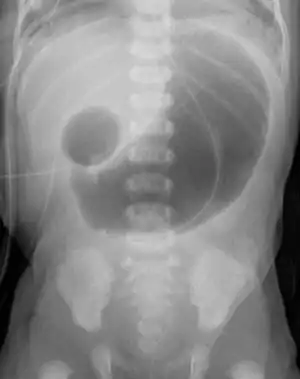Duodenal atresia
Duodenal atresia is the congenital absence or complete closure of a portion of the lumen of the duodenum. It causes increased levels of amniotic fluid during pregnancy (polyhydramnios) and intestinal obstruction in newborn babies. Radiography shows a distended stomach and distended duodenum, which are separated by the pyloric valve, a finding described as the double-bubble sign.
| Duodenal atresia | |
|---|---|
 | |
| Radiograph with double-bubble sign from duodenal atresia | |
| Specialty | Medical genetics |
Treatment includes suctioning out any fluid that is trapped in the stomach, providing fluids intravenously, and surgical repair of the intestinal closure.
Presentation
Complications
Prognosis is usually very good, although complications are more likely to occur when there are serious congenital anomalies.[1] Late complications may occur in about 12 percent of patients with duodenal atresia, and the mortality rate for these complications is 6 percent.[2]
Associated conditions
Approximately 20–40 percent of all infants with duodenal atresia have Down syndrome and 50% have a congenital cardiac anomaly. [3] Approximately 8% of infants with Down syndrome have duodenal atresia.[4]
Diagnosis
The diagnosis of duodenal atresia is usually confirmed by radiography. An X-ray of the abdomen shows two large air filled spaces, the so-called "double bubble" sign.[5][6] The air is trapped in the stomach and proximal duodenum, which are separated by the pyloric sphincter, creating the appearance of two bubbles visible on x-ray. Since the closure of the duodenum is complete in duodenal atresia, no air is seen in the distal duodenum.Atresias occurring distal to the duodenum are usually caused by vascular accidents or ischemic insult, such as jejunoileal atresia.
Physical examination
During pregnancy, duodenal atresia is associated with increased amniotic fluid in the uterus, which is called polyhydramnios.[4] This increase in amniotic fluid is caused by the inability of the fetus to swallow the amniotic fluid and absorb it in their digestive tract.
After birth, duodenal atresia may cause abdominal distension, especially of the upper abdomen. Bilious or non bilious vomiting, depending on the position of the atresia in relation to the Ampulla of Vater, commonly occurs within the first day of life.
Treatment
Early treatment includes removing fluids from the stomach via a nasogastric tube, and providing fluids intravenously.[1] The definitive treatment for duodenal atresia is surgery (duodenoduodenostomy or duodenojejunostomy), which may be performed openly or laparoscopically.[7] The surgery is required but not immediately urgent - a 24 to 48-hour delay is permissible to facilitate transport, further evaluation and fluid resuscitation.[1] The initial repair has a 5 percent morbidity and mortality rate.[2]
Epidemiology
Duodenal atresia occurs in 1 in every 5,000–10,000 live births.[1]
References
- Kimura, Kim; Loening-Baucke, V (May 1, 2000). "Bilious vomiting in the newborn: rapid diagnosis of intestinal obstruction". American Family Physician. 61 (9): 2791–8. PMID 10821158. Retrieved 16 September 2012.
- Escobar, Mauricio A; Ladd, AP; Grosfeld, JL; West, KW; Rescorla, FJ; Scherer LR, 3rd; Engum, SA; Rouse, TM; Billmire, DF (June 2004). "Duodenal atresia and stenosis: long-term follow-up over 30 years". Journal of Pediatric Surgery. 39 (6): 867–71, discussion 867–71. doi:10.1016/j.jpedsurg.2004.02.025. PMID 15185215. Retrieved 16 September 2012.
- Bethell, George Stephen; Long, Anna-May; Knight, Marian; Hall, Nigel J.; BAPS-CASS (2019-06-22). "Congenital duodenal obstruction in the UK: a population-based study". Archives of Disease in Childhood. Fetal and Neonatal Edition: fetalneonatal-2019-317085. doi:10.1136/archdischild-2019-317085. ISSN 1468-2052. PMID 31229958.
- "Duodenal Atresia". Archived from the original on 2012-08-05. Retrieved 2007-12-03.
- Poki HO, Holland AJ, Pitkin J (2005). "Double bubble, double trouble". Pediatr. Surg. Int. 21 (6): 428–31. doi:10.1007/s00383-005-1448-z. PMID 15912365.
- Traubici J (August 2001). "The double bubble sign". Radiology. 220 (2): 463–4. doi:10.1148/radiology.220.2.r01au11463. PMID 11477252.
- Spilde, Troy L; St Peter, SD; Keckler, SJ; Holcomb GW, 3rd; Snyder, CL; Ostlie, DJ (June 2008). "Open vs laparoscopic repair of congenital duodenal obstructions: a concurrent series". Journal of Pediatric Surgery. 43 (6): 1002–5. doi:10.1016/j.jpedsurg.2008.02.021. PMID 18558173.
External links
| Classification | |
|---|---|
| External resources |